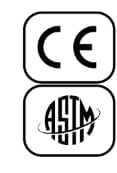In recent years, wearing a ski helmet has become the norm for almost every skier, from the beginner to the expert. That’s because it’s an easy way to protect yourself! Helmets today not only serve to reduce your risk of injury and help your goggles stay in place, but they’re warmer, more comfortable and more fashionable than ever!
If you’re still hesitant to wear a helmet, it’s probably because you haven’t found the right one for you yet. There are models for all needs and tastes; simply take the time to shop around before buying. Here are some key points to consider:
Construction
Shaped with ABS plastic for the shell and reinforced with EPS foam, helmets are built to be strong and light. The helmet works by absorbing and distributing the impact of a collision.
To meet safety standards, your helmet should have the following certification logos:
 EC: The European standard that all helmets must meet or exceed in order to be sold on the European market.
EC: The European standard that all helmets must meet or exceed in order to be sold on the European market.
ASTM: The safety standard that all helmets must meet or exceed to be sold on the market in the United States.
When should I replace my helmet?
Impact: Designed to absorb the impact of a single forceful event, the helmet should preferably be replaced after such a shock.
Time: It is also recommended that you replace your helmet after 5 years of wear. The protective material can lose its strength and durability with time.
Adjustment
One way of checking if your helmet fits properly is to make sure that it doesn’t move around when you shake your head. Most helmets have adjustable strapping systems so you can make adjustments to ensure a good fit. Also, according to the different brands and models, the width and depth of the helmet can vary, so it’s good to try on more than one!
Aeration
Most helmets have openings to keep the head cool and comfortable. Ventilation systems vary, but often consist of slots which allow hot air to escape and fresh air circulation. Most often, these air traps can be opened and closed fairly easily.
Trying on the helmet
Here are some tips from the Association of Quebec Ski Resorts to support you in selecting your helmet:

- It is important to choose a helmet that adapts to the shape of your head:
o The front of the helmet should come down to two fingers above the eyebrows.
o If the front of the helmet gets too low, it will reduce your vision.
o If the front of the helmet back on his forehead, your helmet will not offer much protection a helmet worn properly.
- Tip: Put your goggles in place. If the helmet is worn correctly, you shouldn’t be able to touch your forehead. The glasses should not tilt your helmet backwards. Bring your goggles to the store when buying your helmet!
- The straps are designed to keep your helmet in the correct position. If the straps are not adjusted properly, your helmet will not stay in a comfortable and safe position.
Visit our village shops for great advice and conquer the mountain with a protected head!





